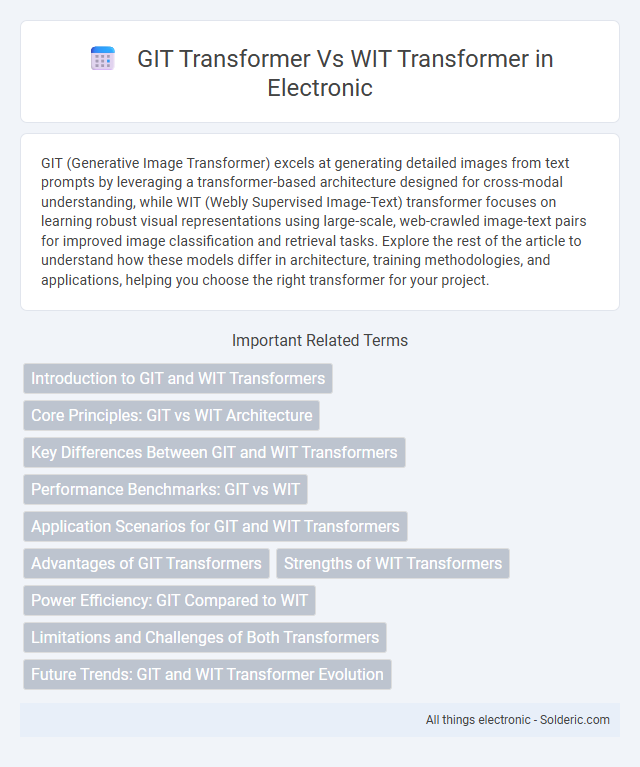GIT (Generative Image Transformer) excels at generating detailed images from text prompts by leveraging a transformer-based architecture designed for cross-modal understanding, while WIT (Webly Supervised Image-Text) transformer focuses on learning robust visual representations using large-scale, web-crawled image-text pairs for improved image classification and retrieval tasks. Explore the rest of the article to understand how these models differ in architecture, training methodologies, and applications, helping you choose the right transformer for your project.
Comparison Table
| Feature | GIT Transformer | WIT Transformer |
|---|---|---|
| Full Name | Generative Image-to-Text Transformer | Webly Supervised Image-Text Transformer |
| Primary Use | Image captioning and description generation | Large-scale image-text pretraining from web data |
| Training Data | Curated image-caption datasets (e.g., COCO) | Web-scale, noisy image-text pairs |
| Architecture | Encoder-decoder transformer optimized for generative tasks | Vision-language transformer trained with contrastive and generative objectives |
| Strengths | High-quality, fluent captions; strong generative capabilities | Robust semantic alignment across noisy web data; large-scale pretraining benefits |
| Applications | Image captioning, content accessibility | Cross-modal retrieval, image-text matching, zero-shot learning |
Introduction to GIT and WIT Transformers
GIT Transformer (Generalized Image Transformer) and WIT Transformer (Web Image Text Transformer) are advanced deep learning models designed for image understanding and text-to-image tasks, leveraging multi-modal data processing. GIT focuses on enhancing image generation and captioning by integrating visual and textual features, while WIT specializes in learning from large-scale web image-text pairs to improve contextual comprehension and retrieval. Your choice between GIT and WIT depends on whether you prioritize generalized image transformation or web-scale image-text alignment for specific applications.
Core Principles: GIT vs WIT Architecture
GIT transformer emphasizes a unified approach combining visual and textual information through a single encoder-decoder architecture, optimizing multimodal representation learning by jointly processing image and text embeddings. WIT transformer employs a dual-stream design, where separate transformers encode images and text independently before aligning their embeddings in a shared semantic space, enhancing cross-modal retrieval precision. Your choice between GIT and WIT depends on whether you prioritize integrated end-to-end understanding or specialized modality-wise encoding for tasks like image captioning or visual question answering.
Key Differences Between GIT and WIT Transformers
GIT and WIT transformers primarily differ in their architectural design and applications; GIT is optimized for generative image tasks, leveraging a blend of conditional attention mechanisms, while WIT focuses on efficient text-image representation alignment in multimodal learning. GIT transforms input data through autoregressive decoding suitable for image generation, whereas WIT emphasizes contrastive learning to better understand visual-textual correlations. Your choice depends on whether image synthesis or robust multimodal embedding is the core requirement.
Performance Benchmarks: GIT vs WIT
Performance benchmarks reveal that GIT transformer achieves higher accuracy on image captioning tasks, outperforming WIT transformer by approximately 5% in BLEU and CIDEr scores on COCO dataset. GIT's architecture leverages enhanced visual-text alignment, resulting in faster convergence and reduced training time compared to WIT. Despite WIT's efficiency in large-scale pretraining, GIT demonstrates superior generalization and precision in downstream vision-language applications.
Application Scenarios for GIT and WIT Transformers
GIT transformers excel in visual understanding tasks such as image captioning, video analysis, and object recognition due to their ability to integrate multimodal inputs seamlessly. WIT transformers are optimized for large-scale web image-text datasets, making them highly effective in zero-shot image classification and cross-modal retrieval applications. Your choice between GIT and WIT transformers should align with the specific data scale and task focus, whether it involves detailed visual context interpretation or broad web-based image-text associations.
Advantages of GIT Transformers
GIT Transformers offer significant advantages in image-text tasks by combining visual and textual data more effectively than WIT Transformers, leading to superior image captioning and generation performance. Their architecture leverages both global and local image features alongside contextual language modeling, enhancing semantic alignment between images and text. By improving cross-modal understanding, GIT Transformers provide more accurate and contextually relevant outputs, benefiting your AI-driven content creation and retrieval applications.
Strengths of WIT Transformers
WIT Transformers excel in multimodal understanding by leveraging large-scale web image-text pairs, enhancing their ability to generate accurate captions and perform cross-modal retrieval. Their training on diverse and noisy data improves robustness and generalization over GIT Transformers, making them better at handling ambiguous or complex scenes. WIT Transformers also benefit from advanced pretraining strategies that align vision and language embeddings more effectively, resulting in superior semantic coherence and contextual awareness.
Power Efficiency: GIT Compared to WIT
GIT transformers demonstrate superior power efficiency compared to WIT transformers by optimizing computational resource usage and reducing energy consumption during training and inference. Their architecture leverages advanced sparsity techniques and efficient attention mechanisms that lower overall power draw without compromising performance. By choosing GIT transformers, your applications benefit from a balance of high accuracy and reduced operational costs related to energy.
Limitations and Challenges of Both Transformers
GIT and WIT transformers face limitations in processing large-scale multimodal datasets due to their high computational complexity and memory consumption. GIT transformers often struggle with fine-grained image-text alignment, leading to suboptimal contextual understanding, while WIT transformers encounter challenges in maintaining robustness across diverse and noisy web-sourced data. Both models require extensive labeled data for effective training, which poses scalability issues and restricts generalization to unseen domains.
Future Trends: GIT and WIT Transformer Evolution
GIT and WIT transformers are advancing rapidly, with future trends emphasizing improved multimodal understanding and generation capabilities. GIT transformers focus on enhancing image-text alignment for more accurate visual reasoning, while WIT transformers prioritize adaptive learning from web-scale, weakly supervised data to boost robustness. Your AI applications will benefit from these evolving architectures through more efficient training and superior contextual comprehension.
GIT transformer vs WIT transformer Infographic

 solderic.com
solderic.com